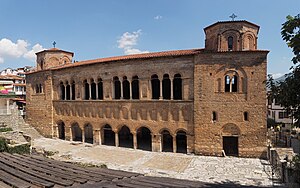Sophienkirche (Ohrid)
The Sophienkirche ( Macedonian Црква Света Софија , Crkva Sveta Sofija ) is a Byzantine church building in the city of Ohrid in North Macedonia .
The church is a three-aisled pillar basilica with a narthex and exonarthex in the west and a portico attached to the north .
history
Ohrid has long been one of the cultural and religious centers of the Bulgarian Empire and one of the centers of Orthodox Christianity of the Slavs and Southeastern Europe. During the reign of Tsar Samuel (958-1014), Ohrid became the Bulgarian capital before the country and city were taken by Byzantine troops in 1018.
The Sophienkirche was then built on the foundations of an early Christian church between 1037 and 1056 during the tenure of Archbishop Leo von Ohrid , a cleric of Greek descent. Leo was Archbishop of the Autocephalous Archdiocese of Ohrid and appointed by Byzantium. He had a three-nave church built with three apses, a mighty dome over the central section and a bell tower in front of the west facade. In 1313/14, under Archbishop Gregorios, the building was extended to the west by a two-story exonarthex (vestibule) with two domes and galleries on the upper floor.
After the conquest of the region around Ohrid by the Ottoman Empire between 1385 and 1408, the church was converted into a mosque , the bell tower, the central dome and the inner galleries were demolished.
After the Russo-Ottoman War of 1877/78, the rule of the Ottoman Empire in the region ended and the Church of St. Sophia could be restored to its original function as a Christian church.
In 1967 the Macedonian Orthodox Church , not recognized by other Orthodox churches, was founded in the Sophienkirche . Since then, Ohrid has belonged to the Diocese of Debar and Kičevo under canon law and no longer plays an administrative role.
The frescoes of the Sophienkirche

In the church you can see the numerous frescoes with which its walls were painted in the 11th century. The frescoes in the church are an example of how local art interacts with the influences coming from Constantinople. The paintings, the artists of which may have been sent from Byzantium, are one of the many creative achievements of the region, which, coming via Byzantium and also from Ohrid, influenced the medieval world of the Balkan countries. This is not the only reason why the frescoes in the Sophienkirche as part of the city of Ohrid are now a World Heritage Site .
The frescoes were created in a field of tension between the already mature West Byzantine art , which came from antiquity, and the striving for local independence from the central empire and its style specifications. It is noticeable that they were painted with a blue and not, as is usually the case in Constantinople, with a gold background. They also testify to knowledge of the new Romanesque fresco art in “ Latin ” Italy and, despite the spatial distance, from a certain orientation of the region towards Venice and all of Italy - although the pictures still strictly follow the schematic representation rules of the time before the picture dispute.
The frescoes have thus mainly drawn their inspiration from the rich tradition of Byzantium and have submitted to the regulations and ideas of their clients. Her style of painting is based on long-term mature solutions and recognized schemes. Nevertheless, the choice of color and the representation of the architecture reveal an independence that made the work of art in the church a masterpiece of new painting in the Balkans region of the 11th century. It turns out that the elite in the nobility and the church in the region were largely Hellenized. The Slavic character of the archbishopric in Ohrid was therefore only further cultivated by the lower clergy, but a comparison with the Russian masterpieces of the same period, also from Byzantine art, such as the frescoes and mosaics in Novgorod, shows that art in Ohrid nevertheless did not look so closely tied to the Byzantine models. The frescoes in Ohrid can be seen as interpretations of the texts by Johannes Damaskenos , a Syrian church father of the 7th / 8th centuries. Century, who had advocated the worship of images in the picture dispute against the emperors Leo and Constantine .
All frescoes in the Sophienkirche had been painted over during the rule of the Ottoman Empire and the use of the church as a mosque during this time and were forgotten. The frescoes were rediscovered between 1950 and 1957 and are now regarded as an important work for the region and its art history, but also for understanding the entire development of European art.
Individual evidence
- ↑ Lexicon of the Middle Ages. Vol. 6, Col. 1378.
literature
- Vojislav J. Đurić: The Church of St. Sophie in Ohrid . Jugoslavija, Belgrade 1963.
- Barbara Schellewald : The architecture of the Sophienkirche in Ohrid . Dissertation Bonn 1986.
- B. Čipan: St Sophia, the cathedral church of the Ohrid archbishopric . In: Macedonian Review. 27 / 1-2, 1997, pp. 22-40.
- Barbara Schellewald: Johannes Chrysostomos and the rhetoric of the pictures in the Bema of the Sophienkirche in Ohrid . In: Martin Wallraff , Rudolf Brändle (Hrsg.): Chrysostom pictures in 1600 years. Facets of the history of the impact of a church father. de Gruyter, Berlin / New York 2008, pp. 169–192.
Web links
- City, lake and surroundings of Ohrid, Macedonia , TV report from Treasures of the World - Heritage of Mankind. Episode 274, SWR.de, broadcast on Sunday, June 1, 2003 (accessed June 2011)
Coordinates: 41 ° 6 ′ 43.5 " N , 20 ° 47 ′ 38.8" E

